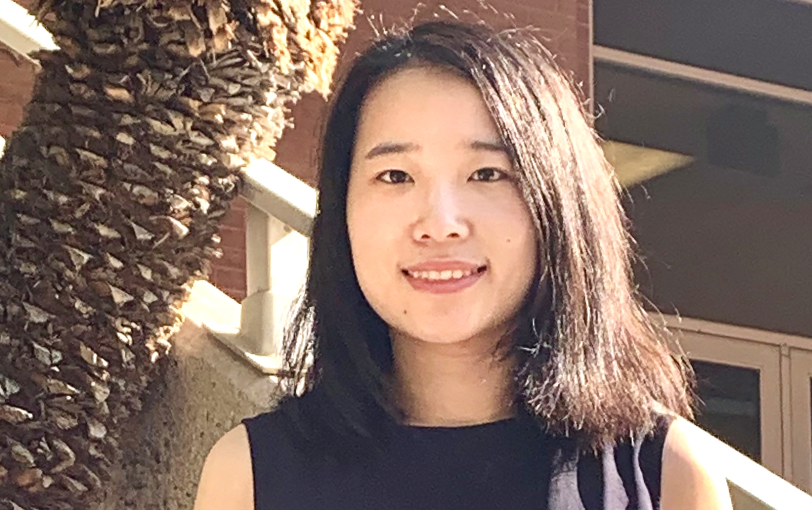Xinru Wang wins 2019 Klein Award for research on cell signaling in enzymes
Using SLAC’s X-ray synchrotron SSRL, Wang improves fundamental knowledge about how cells communicate, which could enable the development of more effective drugs.
By Ali Sundermier
Xinru Wang, a postdoctoral fellow at the University of Arizona, has been interested in biology ever since middle school. She says she’s always been excited at the thought of seeing molecules and the details of functional proteins.
Now, Wang has been selected to receive the 2019 Melvin P. Klein Scientific Development Award for her research on cell signaling in enzymes, which could one day lead to more effective drugs. She will accept the award at the SSRL/LCLS Annual Users’ Meeting at the Department of Energy’s SLAC National Accelerator Laboratory, where she will also give a talk about her research.
The Klein award recognizes outstanding research accomplishments by undergraduates, graduate students and postdocs within three years of receiving their PhD who used SLAC’s Stanford Synchrotron Radiation Lightsource (SSRL) for their research. Established in 2006 by the SSRL Users’ Executive Committee, the award honors the late Melvin P. Klein, a biophysicist and pioneer in the field of spectroscopic methods, including X-ray absorption spectroscopy.
“I felt really honored to learn that I’d be receiving the Klein award,” Wang says. “My first synchrotron experiments were done at SSRL, so I feel a special bond with the facility and the beamline scientists who work there. I remember the excitement of staying up all night until the sun rose while I collected the data for my first crystal structure using SSRL. It feels really good to have my work recognized and appreciated by the community.”

Fundamental discoveries
Wang’s research explores a small class of enzymes called serine/threonine phosphatases that play a crucial role in cell function. Her focus is on a process called dephosphorylation in which a phosphate group is taken away by the enzyme, either activating or deactivating a cellular event. She is specifically interested in how these enzymes identify their substrates – the molecules on which they act to produce chemical reactions – and how these chemical modifications change their ability to interact with other proteins.
To learn more about these interactions, Wang grows crystals of these enzymes bound to their substrates, and then blasts them with X-rays from SSRL. The patterns formed when the X-rays diffract allow Wang to determine the structure of the enzyme-substrate complexes and better understand the changes they undergo.
In a recommendation letter, her mentor and PhD advisor Rebecca Page, a professor at the University of Arizona, says that Wang’s studies have resulted in several fundamental discoveries in the field of cell signaling – how cells relay messages to each other through chemical signals to govern basic activities and coordinate their actions.
“Her work has identified a new, critical substrate interaction that can now be exploited to develop novel tools and potential drugs that specifically disrupt a single phosphatase – a tool that has eluded the field for more than half a century,” Page says.
Seeing in detail
Wang began working with Page at Brown University as a graduate student and followed her to the University of Arizona to continue her research, giving her the opportunity to split her graduate school experience between two very different environments. Page says she’s enjoyed seeing Wang develop as a scientist during her graduate career.
“She has an open collaborative personality that makes her a delight to have in the laboratory,” Page says. “She is careful and conscientious with her experiments and not afraid to learn new techniques in order to answer the biological question at hand. She is also an outstanding communicator. But, most importantly, she is driven to understand biology, especially the molecular mechanisms in enzymes that lead to the highly regulated and specific dephosphorylation of substrates – events that are absolutely essential for all cellular communication.”
Wang says that what drew her to molecular biology was the desire to understand all of the different functions proteins can have and how they carry them out, and she appreciates the opportunity to learn more.
“I was always fascinated by the diversity of life,” Wang says. “So much of that diversity is contained within people, animals, insects and plants. It seems like such a big world and I love that I get to see more and more details of it through my research.”
SSRL is a DOE Office of Science user facility. The SSRL Structural Molecular Biology program and facilities that Wang uses for her research are funded by the DOE Office of Biological and Environmental Research, and the National Institutes of Health, National Institute of General Medical Sciences.
For questions or comments, contact the SLAC Office of Communications at communications@slac.stanford.edu.
SLAC is a vibrant multiprogram laboratory that explores how the universe works at the biggest, smallest and fastest scales and invents powerful tools used by scientists around the globe. With research spanning particle physics, astrophysics and cosmology, materials, chemistry, bio and energy sciences and scientific computing, we help solve real-world problems and advance the interests of the nation.
SLAC is operated by Stanford University for the U.S. Department of Energy’s Office of Science. The Office of Science is the single largest supporter of basic research in the physical sciences in the United States, and is working to address some of the most pressing challenges of our time. For more information, please visit science.energy.gov.




